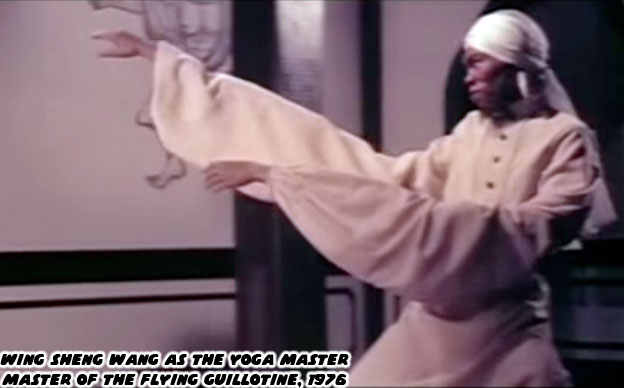
What was interesting was how other forms of "fighting" had to have a strong gimmick in order for audiences to accept that they were effective against kung-fu. Yoga for example was not a martial art but instead a philosophical school and method of exercise. Practitioners of the arts from India wore a turban and could stretch their limbs. This was what movies taught us. Young fans accepted this at face value.
Yoga had actually been used as a rival fighting art in the prequel to the Master of the Flying Guillotine. In the One Armed Boxer Chun Lin Pan wore literal blackface and played a yoga mystic. There were no minority groups to protest their representation in cinema back in the early '70s. The Yoga Master was seemingly invulnerable, he could absorb a knife stab without bleeding and could teleport around his opponents by standing on his hands. Certainly we could see how absurd this was in hindsight but imagine playing the movie in places that were still rooted in strong supernatural and religious beliefs. For all the movie goers knew there were really people in India that could do this.
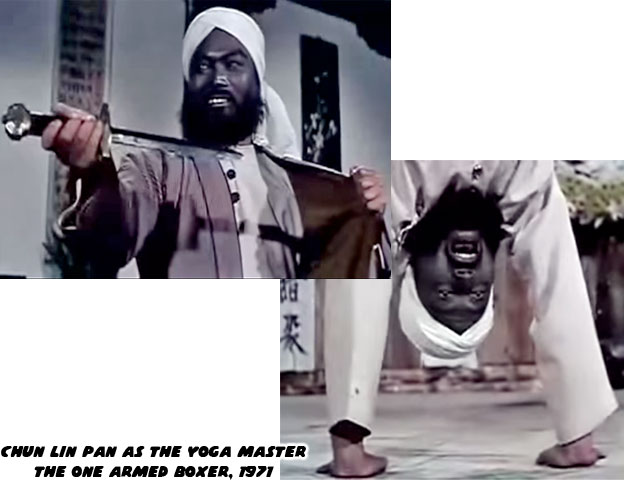
Even when there were actual Indians cast in the role they still relied on gimmicks in order to get audiences to watch the film. Such was the case of contortionist Dupar Singh in Kung Fu vs Yoga. The performer didn't really kick or punch his opponents as much as he danced around them and avoided their strikes with his limberness. Certainly some of the poses used by Dupar may have originated from Yoga but it took a clever choreographer to work them into a routine for the movie. These representations of the art did not go unnoticed by the developers working in Japan. When Capcom was filling out a cast for Street Fighter and Street Fighter II they would often reference films, television shows and manga characters for their cast. Sometimes the inspiration was passing and other times it was heavy handed.
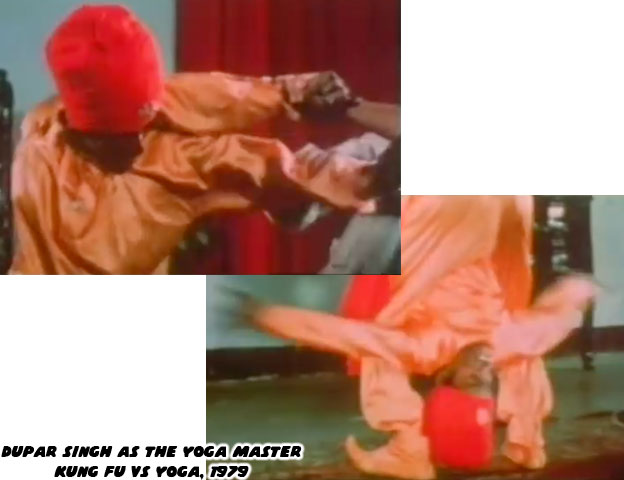
The representations of the foreign fighting arts were sometimes done with a sense of history and respect. See Sagat and Adon for proof. However some of the more "exotic" arts were pulled out of thin air at the whims of the designers.
Long-time fans of the series might not have believed that in the early stages Dhalsim wore an elephant mask and could have sported six arms. Talk about being disrespectful to Indians and those that believe in Ganesh! He was known as the "Great Tiger." Those that were familiar with the Punch-Out boxing series by Nintendo probably also remember seeing an Indian boxer wearing a turban with the same exact name. The Indian-as-a-fighter gimmick was heavily influenced by pro wrestler Tiger Jeet Singh. He would often come to the arena wearing a turban and wildly swinging a saber. He scared audiences with his antics. The wrestler was very famous in the '70s and '80s when the designers at Capcom would have been most influenced by pop culture.
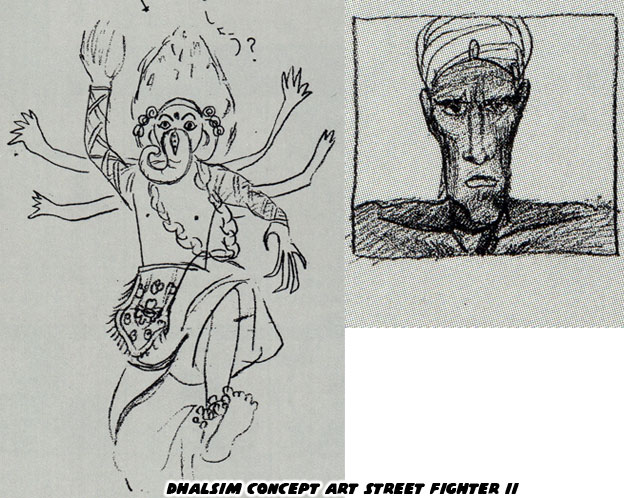
Tiger would have extremely violent matches against other characters like "the Sheik" and "the Butcher." He was able to make a good living by exploiting a gimmick that had little to no basis on reality. Audiences fell for it and by extension helped perpetuate a myth about Indian fighters. Singh had a son that carried the name and the gimmick into a new generation.
Great Tiger was supposed to be an Indian mystic but his look was very bland. He was a dark-skinned character with a turban, he could have been pulled right out of any comic book. Not much else was known about this figure, what form of fighting he represented or what his abilities were. This was when the team looked to a few new points of reference. Where had they seen Indian fighters before and what made them special? Of course the Indian was well known in television and cartoon tropes. Who does not remember seeing a cartoon of an Indian lying on a bed of nails, or running swords through a basket with their apprentice inside? What about the classic Indian rope trick or the Madari better known as the snake charmers?
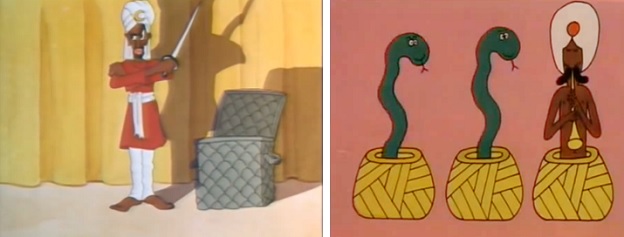
These were things that everyone had seen and was familiar with. Yet these things could have also been negative subconscious cues about a particular culture. India had introduced words like Guru and Yogi into Western language. Whether true or not these images of Indians colored pop culture the world over. Magicians from India were part of folklore and many assumed that there was some truth to these legends. The second Indian character feature in the Wang Yu films was even more memorable. He had arms that stretched, creating a very unique challenge for the hero of the film. It was an impressive effect in the film, using prosthesis and a second person to create the illusion. This character, blackface and all, had a profound influence on the development of the Great Tiger.
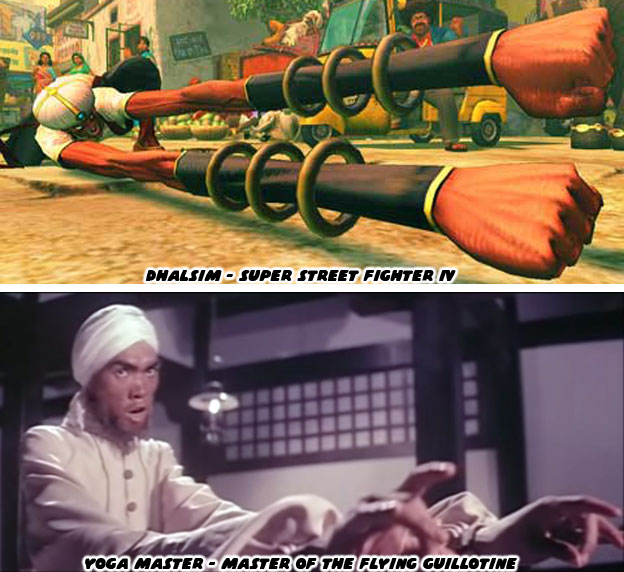
As Dhalsim began to emerge the designers wanted to know how else they could make him unique. Again they used the Indian mystic as a point of reference. In legend the magicians from India and Arabia were highly tolerant to fire. They could walk on hot coals and even breathe flames. These performers ended up in traveling caravans and helped create the myth that found its way to film and television centuries later. The best thing about Street Fighter was that there was a hint to truth to the icons. There was a caste of Sikh Warriors that were armed with weapons and trained in the art of war. During celebrations they would parade in uniform and sometimes put on a show for audiences, singing, dancing and breathing fire. It was an amazing visual. Imagine an animated version of a Sikh warrior in a battle against a karate master. There was real potential in trying to recreate these different arts for game playing audiences.
The team at Capcom began experimenting with the look and moves of the Great Tiger. They stripped away the turban and Sikh costume and made him appear very humble. In Sikh practice hair was a sacred, it was never exposed and was kept wrapped up. Dhalsim was supposed to appear more like a beggar. Literally someone that gave up his worldly possessions and even shaved himself bald to humble himself. A pair of ragged trunks and a rope belt became his new costume. Around his neck he wore three small skulls. It would be revealed that these were children from his village that had died. As a pacifist the only reason he entered the Street Fighter tournament to win the prize money to help his village. His backstory would be revealed at the end of the game. Like Chun-Li and Ryu the developers learned that it was important to know what each character was fighting for and why it made them interesting. The developers respected their characters and audience enough to let players discover what made them unique through the endings of the game.
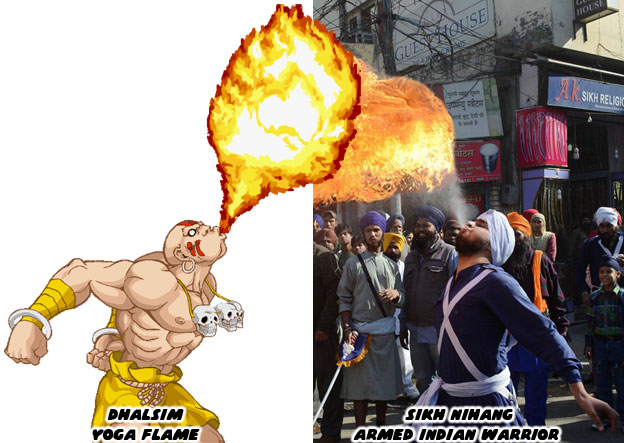
Despite the legends created by cinema some of these representations of the fighting arts in film and manga were based on first-hand accounts of traveling fighters. The trips of Mas Oyama and Yoshiji Soeno became the basis of the Karate Baka Ichidai books. In the journeys they fought students as well as masters of various forms of karate, judo, jujitsu and of course muay thai. When Oyama traveled he would put on exhibitions. Sometimes they would involve him breaking boards and bricks. Sometimes blocks of ice and baseball bats as well. In many early arcade fighting games the bonus levels consisted of these breaking demonstrations to add to their authenticity.
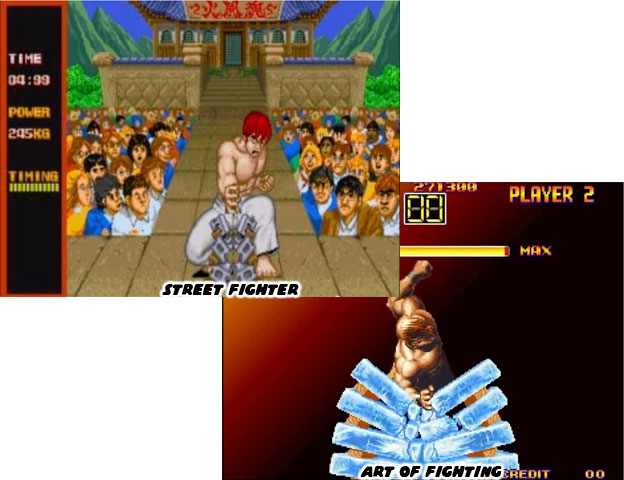
Remember that Oyama had a reputation for being a "God Hand" he could dispatch most of the fighters that challenged him with a single punch. To prove how accurate his strikes were he would chop the tops off of wine bottles. He could legitimately perform this move in real life but when he was touring with American wrestling promoters they did not want to risk him injuring himself. They would score the glass ahead of time. Oyama would put his life on the line multiple times by getting in the arena with a bull. He would chop off its horns and then kill it with a punch to the head. There was no mistaking that he was the real deal.
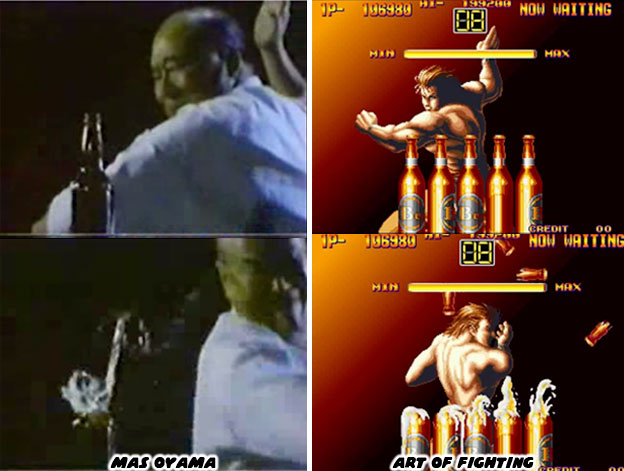
Oyama and his followers would recount how he was able to defeat the best fighters of a particular style. Even if a person was bigger or stronger, had a greater reach, he would always find a way to prove his style was the best. These retellings would become more embellished through the years as they were adapted to manga stories. Remember that his fans couldn't just follow him around with their cell phones and upload the footage to YouTube in the late '50s and early '60s. All they could do was wait for installments of his life story via comic so they could visualize these fights. This would set a precedence that almost every other modern comic would borrow. Start with a fighter and follow them as they challenge themselves against bigger and better opponents. Even the comics based on fighting games didn't deviate from this formula.
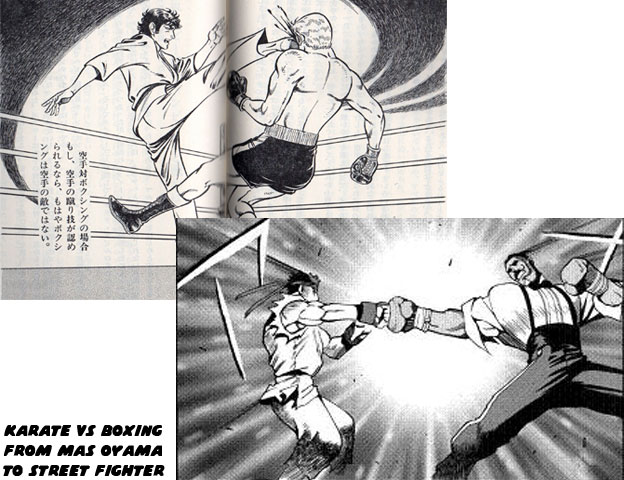
When Oyama was away from the wrestling circuit people would seek him out and challenge him to a duel. In the Americas there wasn't really a defined fighting style. Just about every other nation on Earth had an identifiable form of grappling or striking but not North, Central or South America. Some of the natives and Spanish land owners were known to be good fighters but they fought using knives. Count Kouma could attest to how some Capoeira practitioners were about having access to a knife in combat. The knife thrower would be revisited by Capcom in Final Fight, originally called Street Fighter '89. Holly Wood and El Gado would have some of the trimmings of the Hispanic knife fighters that Oyama spoke of. These techniques were labeled by the designers at Capcom, El Gado for example was a master of Souo-katsuken (Double Scorpion Tail technique).
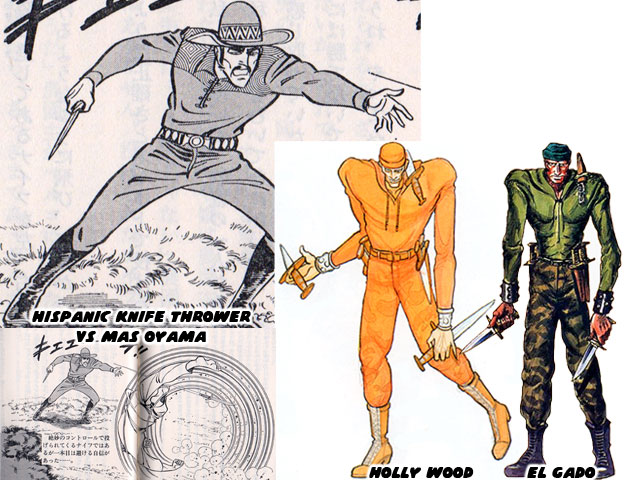
This character would evolve into a sort of sadistic mercenary. In the early planning stages of Street Fighter II they had even considered putting a knife fighter in the lineup. The fighters was slightly crazed but at the same time boasted an IQ of 220. El Gado would turn up in other Capcom games as a playable as well as background character and the insane Doctrine Dark would be created by ARIKA and Capcom for the Street Fighter EX series. The knife fighter would only find a limited following in the genre. To represent the Americas most of the Japanese developers would focus on wrestlers instead. This seemed to work out much better in the long run.
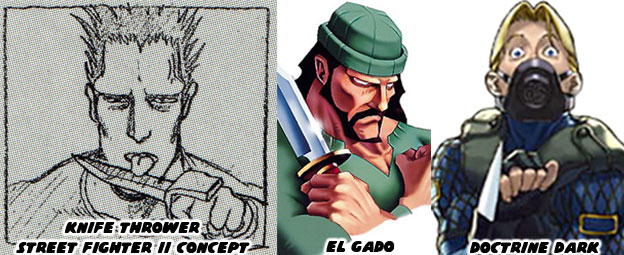
The lesson was learned by producers early on. If you don't have a real fighting art to show off just make something up and stick to your story. It just might convince audiences that this was a real thing. Cinema introduced a new type of hero in the early '70s. These stories would become the foundation for television, film and game heroes for years to come. The next blog will highlight one of the movie pioneers that helped shape the world of fighting games. As always if you enjoyed this blog and would like to sponsor me please visit my Patreon page and consider donating each month, even as little as $1 would help make better blogs and even podcasts!

Hello, I'm curious about the drawing of the fight between the karateka and a boxer; could you tell me the name of the manga?
ReplyDeleteEdo, it was actually from a Mas Oyama karate book Karate versus... where various scenarios are explored. There were only a few illustrations in it.
DeleteThanks. So that was the only illustration with the boxer? I believe this was a recurring theme in their MA comics back in the '70s, '80s and maybe even '90s. I quite like it. Do you know of other examples of challenge matches or sparring sessions between boxers and karate experts in comic books from that period?
DeleteThat's the only one in that book. There was also a drawing of him versus a wrestler and him versus an ape. All of the opponents got a kick to the face. Your best bet would be to track down the Karate Baka Ichidai manga. I bet there are scans online. There have been other karate books over the years, eventually most karate guys have to face a boxer in those stories. I'm sure if you dig online you'll find more examples.
Delete